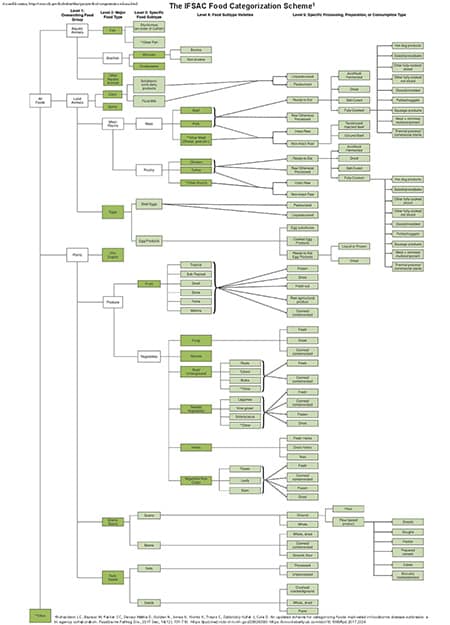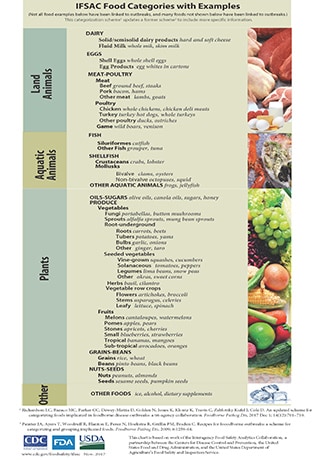IFSAC Food Categorization Scheme
The IFSAC food categorization scheme has five distinct levels to which foods can be assigned, depending upon the type of food. First, foods are assigned to one of four food groups (aquatic animals, land animals, plants, and other). Food groups include increasingly specific food categories; dairy, eggs, meat and poultry, and game are in the land animal food group, and the category meat and poultry is further subdivided into more specific categories of meat (beef, pork, other meat) and poultry (chicken, turkey, other poultry). Finally, foods are differentiated by differences in food processing (such as pasteurized fluid dairy products, unpasteurized fluid dairy products, pasteurized solid and semi-solid dairy products, and unpasteurized solid and semi-solid dairy products.
The IFSAC Food Categorization Scheme
Download print version [PDF – 1 page]
IFSAC Food Categories With Examples
Aquatic Animals
Aquatic Animals includes three major food types, Fish, Shellfish, and Other Aquatic Animals.
- The Fish is divided into Siluriformes (an order of Catfish), and other fish.
- The Shellfish food type is divided into Mollusks and Crustaceans. The Mollusks sub-type is further divided into Bivalve Mollusks, with clams and oysters as examples, and Non-bivalve Mollusks, with octopuses and squid as examples.
- The food type, Other Aquatic Animals, includes frogs and jellyfish as examples.
Land Animals
Land Animals includes four major food types, Dairy, Game, Meat-Poultry, and Eggs.
- Dairy is divided into solid/semi-solid dairy products and fluid milk which include both unpasteurized and pasteurized.
- Eggs are divided into shell eggs and egg products. Shell eggs processing examples are pasteurized and non-pasteurized. Eggs Products are further divided into egg substitutes, cooked egg products and read-to-eat egg products. Examples in Eggs include whole shell eggs, and egg whites in cartons.
- Meat-Poultry is divided into two food sub-types, Meat and Poultry.
- Meat is divided into Beef, Pork, and Other Meat. Beef and Pork processing examples are ready-to-eat*, raw otherwise processed, intact raw, and non-intact raw. Examples of non-intact raw are tenderized/injected beef and ground beef. Beef, with ground beef and steaks as examples, Pork, with bacon and hams as examples, and Other Meat, with lambs and goats as examples.
- Poultry is divided into three food sub-types Chicken, Turkey, and Other Poultry. Chicken and Turkey processing examples are ready-to-eat*, raw otherwise processed, intact raw, and non-intact raw. Other-Poultry are further divided into intact raw and non-intact raw. Whole chickens and chicken deli meats as examples, Turkey, with turkey hot dogs and whole turkeys as examples, and Other Poultry, with ducks and ostriches as examples.
- Game sub-category includes wild boars and venison as examples.
*Ready-to-eat are sub-divided into sub-divided into acidified, dried, salt-cured, and fully-cooked** for food sub-types Beef, Pork, Chicken, and Turkey.
**Fully-cooked examples include hot dog products, salad/spread/pate, other fully-cooked sliced and not sliced, diced/shredded, patties/nuggets, sausage products, meat and non-meat multi-component, thermal process/commercial sterile.
Plants
Plants includes four major food types, Oils-Sugars, Produce, Grains-Beans, and Nuts-Seeds.
- Examples in Oils-Sugars include olive oils, canola oils, sugars, and honey.
- Produce is divided into Fruits and Vegetables.
- Fruits, is further divided into tropical, sub-tropical, small, stone, pome, and melons. Melons, with examples cantaloupes and watermelons; Pomes, with examples apples and pears; Stones, with examples apricots and cherries; Small, with examples blueberries and strawberries; Tropical, with examples bananas and mangoes; and Sub-tropical, with examples avocadoes and oranges. Processing examples include frozen, dried, fresh-cut, raw agricultural product, and canned/containerized.
- Vegetables is further divided into Fungi, Sprouts, Root-underground vegetables, Seeded vegetables, Herbs, and Vegetable row crops.
- Fungi are further divided into processing examples fresh, dried, and canned/containerized. Examples in Fungi include portabellas and button mushrooms.
- Examples in Sprouts include alfalfa sprouts and mung bean sprouts.
- Root-underground vegetables, is further divided into Roots, with examples carrots and beets; Tubers, with examples potatoes and yams; Bulbs, with examples garlic and onions; and Other, with examples ginger and taro. Processing for root-underground can be fresh or canned/containerized.
- Seeded vegetables, includes Vine-grown, with examples squashes and cucumbers; Solanaceous, with examples tomatoes and peppers; Legumes, with examples lima beans and snow peas; and Other, with examples okras and sweet corns.
- Examples in the sub-category Herbs include basil and cilantro. Processing examples are fresh herbs, dried herbs, or teas.
- Vegetable row crops are further divided into Flowers, with examples artichokes and broccoli; Stems, with examples asparagus and celeries; and Leafy vegetable row crops, with examples lettuce and spinach.
- Grains-Beans, are divided into Grains, with examples rice and wheat; and, Beans, with examples pinto beans and black beans.
- Nuts-Seeds, is divided into Nuts, with examples peanuts and almonds; and, Seeds, with examples sesame seeds and pumpkin seeds. Processing examples for nuts include processed and unprocessed. Processing examples for seeds include crushed/cracked/ground, whole/dried, and paste.
Other
Examples include ice and dietary supplements.
These charts are based on work of the Interagency Food Safety Analytics Collaboration, a partnership between the Centers for Disease Control and Prevention, the United States Food and Drug Administration, and the United States Department of Agriculture’s Food Safety and Inspection Service.
Richardson LC, Bazaco MC, Parker CC, Dewey-Mattia D, Golden N, Jones K, Klontz K, Travis C, Zablotsky Kufel J, Cole D. An updated scheme for categorizing foods implicated in foodborne disease outbreaks: a tri-agency collaboration. Foodborne Pathog Dis. 2017 Sep 19, ahead of print. Read the abstract.
Painter JA, Ayers T, Woodruff R, Blanton E, Perez N, Hoekstra R, Griffin PM, Braden C. Recipes for fooodborne outbreaks: a scheme for categorizing and grouping implicated foods. Foodborne Pathog Dis, 2009; 6:1259-64. Read the article.

